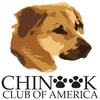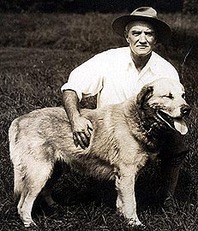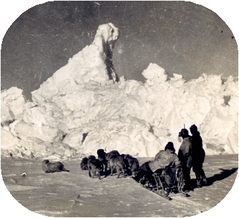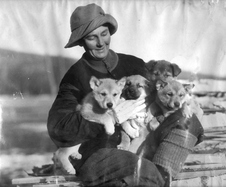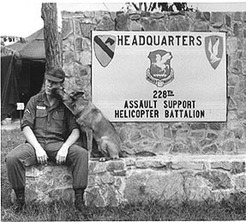|
A Brief History of the Chinook
The Chinook was the inspiration of Arthur Treadwell Walden, a sled-dog driver, author, explorer, and innkeeper from the village of Wonalancet, which is nestled at the foot of the White Mountains in north central New Hampshire. Walden created a distinctly tawny, American sled dog that had power, endurance and speed, along with a friendly, gentle nature. Chinook and his family Walden's foundation dogs for the Chinook Breed were descendants of Admiral Peary's Greenland husky lead dog, Polaris, and a mastiff-type farm dog who produced a litter of three pups on January 17, 1917, in New Hampshire. The pups were named Rikki, Tikki and Tavi after the mongoose in Rudyard Kipling's The Jungle Book. One of these pups was eventually called "Chinook" after a sled dog Walden had used while freighting supplies for gold miners in the Yukon. This dog was the foundation dog of the Chinook breed and is the dog to which all Chinooks are related. Chinook grew to be 100 pounds. In Walden's bookHarness and Pack, Walden described Chinook as "a large tawny yellow dog, a half-bred Eskimo, with dark ears and muzzle�.Chinook was known not only as a wonderful sled dog, but also for his gentle disposition toward children. Descendants of Chinook would later be called "Chinooks" in honor of the foundation sire. Walden and his dog sled team, with Chinook in lead, were credited with bringing the sport of sled dog racing to New England. In 1924, Walden founded the New England Sled Dog Club, the oldest club of its kind still in operation today. In 1927, Walden was appointed to head the Dog Department for Admiral Richard Byrd's first Antarctic Expedition (BAE I). Walden and his sixteen Chinook dogs were described by Admiral Byrd as the backbone of the expedition transport. In fact, in 1931, Arthur Walden received the Congressional Medal for his part in Admiral Richard Byrd's Antarctic Expedition. Unfortunately, it was in Antarctica that Chinook was lost nearing his twelfth birthday - reports of Chinook's death were heard around the world and many mourned the loss of one of the greatest lead dogs in history. At Walden's request, Route 113A from Tamworth to Wonalancet, New Hampshire, now bears the name "Chinook Trail" to honor his famous lead dog. After returning from the Byrd expedition, Walden sold the Chinook Kennels to Milton Seeley and the dogs were moved to a new location about a mile down the road from the Walden homestead. From what historic pedigrees remain, it appears that the modern Chinook breed may be descended from Walden's breedings through just three dogs - Jock, Hootchinoo, and Zembla - who were sold by Walden to kennel partner Julia Lombard prior to embarking on his Antarctic expedition. There have been a number of notable events occurring throughout the Chinook's history: Perry Greene era Chinooks
|
